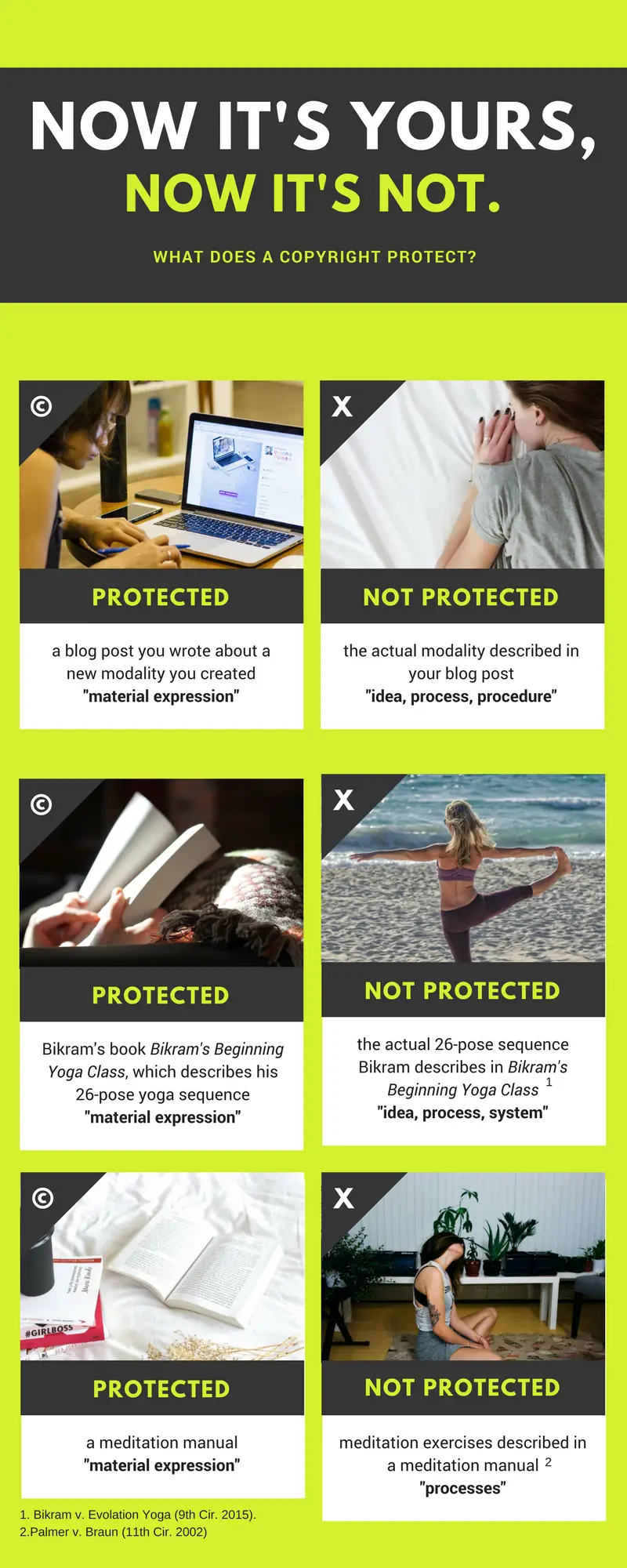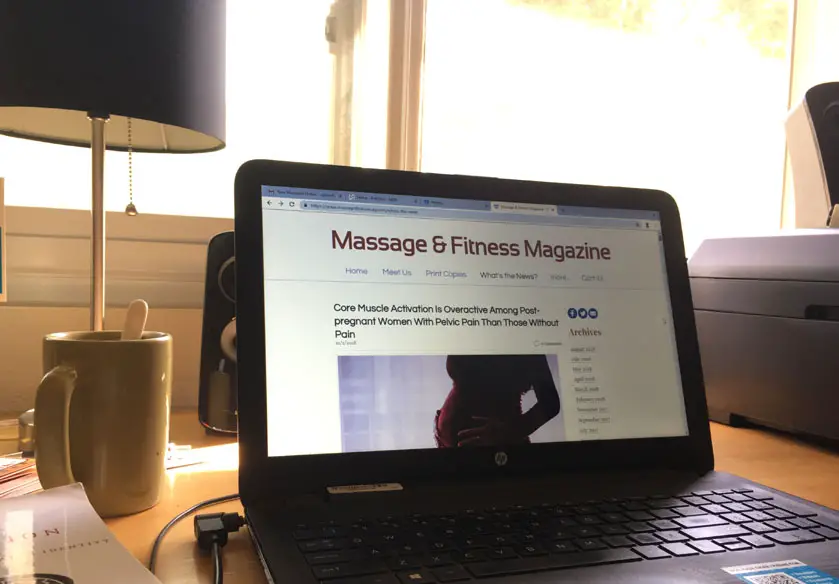There are two primary types of intellectual property about which massage therapists should be aware: copyrights and trademarks. Generally, copyrights protect original works of authorship like writings or illustrations. Trademarks protect words, phrases, symbols, or designs which identify the source of the goods or services. Patents, a third type of intellectual property not addressed in this article, protect inventions or discoveries like a new pharmaceutical drug.
Intellectual property: trademark vs. copyright
To illustrate the distinctions between these terms, consider the example of Bikram Yoga, a specific sequence of 26 poses and two breathing exercises created by Bikram Choudhury. Classes are taught in a 105-degree room to mimic Choudhury’s native Calcutta, India. Claiming that the Bikram sequence fostered specific health benefits to its practitioners, Choudhury moved from India to the United States in the 1970s and eventually opened hundreds of studios. He offered nine-week training programs which resulted in thousands of certified instructors, and he published the book “Bikram’s Beginning Yoga Class,” which detailed and illustrated his signature sequence.
Some Bikram-certified instructors eventually left Bikram studios to establish their own studios, where they continued teaching the 26-pose Bikram sequence. Other yoga practitioners, having no training in the Bikram sequence, relied upon Bikram’s Beginning Yoga Class to offer the sequence in their studios. Choudhury has been an aggressive enforcer of his copyright and trademark rights, to the dismay of many yoga studios. Specific examples of these lawsuits will be discussed throughout this article.
Copyrights protect material expression, not ideas
Copyrights are governed by federal law and give the author the exclusive right to control the reproduction, adaptation, distribution, performance, and display of their work. A copyright protects “original works of authorship” that are “fixed in any tangible medium of expression.” (1)
There are eight categories of work that can be protected by copyright, the most relevant of which for massage therapists include writings, photographs, and videos. (2) The creator of these materials will be described as an “author,” although the mediums of expression vary.
More importantly, a copyright does not protect ideas, processes, systems, concepts, principles, or discoveries. Instead, it protects the therapist’s actual material expression of an idea, process, or concept – that is, the writing or illustration which captures that idea. (3)
For example, while your blog post or article about a new modality is copyrightable, the new modality cannot be protected by copyright. That is, while another person cannot republish your written product without your permission, they may implement the modality in their practice without your consent.
Intellectual property case study: Bikram’s copyright lawsuits
In 2011, Bikram Choudhury sued a competitor’s studio in New York City, Yoga to the People (“YTTP”), which was founded by a former Bikram instructor. Claiming that the studio’s “Traditional Hot Yoga” class violated Choudhury’s copyright to Bikram Yoga, Choudhury alleged that YTTP had impermissibly profited from teaching his sequence.
He demanded that they stop teaching the class and pay him $1 million in damages. The U.S. Copyright Office subsequently clarified that yoga poses are not copyrightable, and previously-granted copyrights like those granted to Bikram were henceforth invalid. (4) Despite this ruling, the yogis settled out of court and YTTP stopped teaching “Bikram Yoga,” though it continued offering non-Bikram hot yoga classes.
Choudhury brought a similar lawsuit against Evolation Yoga the following year, alleging they too had infringed upon his copyright by offering “hot yoga” similar to “Bikram’s Basic Yoga System.” (5) Ultimately, the court determined that while Choudhury had a valid copyright to his book, he could not copyright the yoga sequence or the expression of the ideas described by his book.
In its opinion, the Ninth Circuit Court of Appeals describes this as the “idea/expression dichotomy,” whereby “every idea, theory, and fact in a copyrighted work becomes instantly available for public exploitation at the moment of publication.” (6) This dichotomy seeks to satisfy two competing goals: “copyright assures authors the right to their original expression, but encourages others to build freely upon the ideas and information conveyed by a work.” (7)
Generally, an author obtains a copyright at the moment that she creates the material. (8) However, the author cannot sue another person for infringing upon her copyright until she has registered the copyright with the U.S. Copyright Office. (9)
While not required, those who create copyrightable works are encouraged to include a visible copyright notice. (10) This tells readers that the work is copyrighted and will hopefully deter them from replicating it without permission. If they still infringe upon the copyright, it will be difficult for the reader to claim that they innocently infringed (innocent infringement is a legal defense that a person can raise if they are sued for copyright infringement).
An effective copyright notice has three elements: either the © symbol, the word “Copyright,” or the abbreviation “Copr.;” the year the work was first published; and the name of the copyright owner. For example: “© 2008 Jane P. Doe” is a proper notice.
The takeaway for most providers? Include a copyright notice on your blog posts, presentation slides, or articles. If you create a substantive work – like a book or guide – register your copyright with the U.S. Copyright Office. When sharing others’ work on your social media or website, be sure to give proper attribution to your source and, when in doubt, request the author’s permission prior to sharing.

What intellectual properties are protected and not protected by copyright law. Image by Erin Jackson
Trademarks identify the source of a product and prevent confusion of intellectual property
Trademarks and copyrights are commonly confused, but they serve unique purposes. Frequently, someone who believes their intellectual property has been stolen will sue for copyright and trademark infringement, leaving the court to untangle the nuances of their claims. However, it is crucial to understand the distinctions between copyrights and trademarks to ensure that you are diligently protecting your property.
The law distinguishes between trademarks (which identify the source of a product) and service marks (which identify the source of a service), but they provide similar benefits and are collectively described as “trademarks” here for the sake of simplicity. A trademark is a source-identifying feature that is used in conjunction with a product. (11)
A therapist may trademark her business name, product name, logo, or other symbol – that is, she may trademark a word, name, symbol, figure, letter, or device that she uses to distinguish her products from those sold by others. (12) A trademark must be distinctive, identify the source, and distinguish the trademark owner’s goods or services from those of its competitors. (13) Healthcare providers frequently trademark their business names or logos.
Trademarks which can be classified by the U.S. Patent and Trademark Office (USPTO) as coined, fanciful, arbitrary, or suggestive are deemed to be “inherently distinctive” and may be accorded immediate protection under trademark law. (14) Conversely, descriptive marks which are not inherently distinctive but which acquire distinctiveness or “secondary meaning” over time can be protected by trademark. (15)
A product has developed a “second meaning” when consumers have come to associate it with a particular source. (16) For example, the term SUB-ZERO may not be inherently distinctive (it just means “below zero”), but it does have a “second meaning” as a high-end appliance brand.
Some terms are not protectable. For example, terms of superiority such as best, awesome, supreme, and excellent are generally considered descriptive terms, and are thus not protectable absent a secondary meaning, (17) nor are generic terms and common industry designs and logos. (18,19)
Intellectual property case study: Bikram’s trademarks
Bikram Choudhury has registered the mark BIKRAM YOGA for “educational services, namely, conducting classes, seminars, conferences, and teaching training in the fields of yoga instruction, yoga philosophy, yoga theory and practice, allopathic physical systems, integration of medical and yogic systems, yoga therapy, marketing of yoga instruction, physical fitness, meditation, mental training and discipline, and health, and distributing course materials in connection therewith.” He also registered the mark BIKRAM for those same educational services and for clothing. (20)
Choudhury also tried to register the mark HOT YOGA for the purpose of conducting classes, seminars, conferences, workshops and retreats. However, the U.S. Patent & Trademark office viewed HOT YOGA as a generic term refused to register it. Had they registered it, other studios would have been prevented from using HOT YOGA to describe their classes, which would be unfair to them.
Historically, trademark rights have belonged to those who first and continuously used the mark in commerce (called “common law rights”). (21) While a person can still obtain protectible common law trademark rights, federal law now offers a better way to secure those rights through registration with the U.S. Patent and Trademark Office (“USPTO”). (22)
The first person who applies to register a mark with the USPTO is awarded a formative ownership right on the application date, and the application becomes viable when the mark in used in commerce. Nevertheless, a prior user of that mark who did not register it may still have rights – especially if the geographic area of use overlaps. (23) Further, even a small amount of use in commerce may create trademark rights if it was followed by continuous commercial utilization. (24)
Federal registration of a trademark confers several benefits, including: nationwide priority of use as of the application date (25); exclusive right to use the mark in commerce in connection with the specified goods or services (26); constructive notice to others of the holder’s claim of ownership of the mark (27); the right, after five years of continuous use, to have the registration become incontestable (28); the right to enhanced remedies and relief in cases of counterfeiting (29); and the right to request that U.S. Customs and Border Protection officials bar the importation of goods bearing infringing trademarks. (30)
In addition to federal trademark registration, most states also offer registration for their own trademark registries which are distinct from the USPTO’s registry. For example, Illinois maintains its own trademark registry, but it offers far fewer benefits than federal registration. The benefits in Illinois include an inexpensive application fee and less rigorous application examination procedures. Also, the holder’s state registration may still provide notice to third parties that she has claimed her trademark right, which can help deter innocent infringements.
To obtain a trademark, it is important to retain a trademark attorney who can conduct a trademark search, assess whether the intended mark is protectible, investigate potential conflicts unearthed by the search, and assess the risk of applying based upon the search results. If an application is submitted and a trademark is granted, continued diligence about the proper use and defense of that mark is crucial.
Ownership of a trademark can be indicated by the use of “TM” (for trademarks), “SM” (for servicemarks), or “®” for trademarks registered with the USPTO. (31) The different marks confer distinct benefits and are not synonymous, so it is important to ask a trademark attorney which is appropriate. (32)
Parting intellectual property wisdom
If you did not create something, be careful with its use and always provide an attribution to your source. Whenever you see a copyright or trademark notation (®, ©, TM, SM, Copyright, Copr.), you are on notice that someone has claimed ownership of the content. Before beginning a new venture, be sure that someone else has not already registered a claim to your intended business or product name. Intellectual property violations can result in civil or criminal infringement actions against the wrongdoer, and violations can result in serious civil awards, attorney’s fees, fines, and even jail time.
Exercise particular caution with photos and videos found online, and be aware that people often have heightened protections when someone uses their “likeness” (which might include their photo, name, or quote) without their permission. Always review licensing agreements and terms carefully, as many creators do not allow third-party use without their express written consent. Finally, be aware that there are third-party services that provide copyright searches for companies, it is very easy to get caught.*
*This article discusses the law’s complex treatment of this issue within the United States. Non-American readers should consult their respective tax and legal systems to determine the implications of these issues upon their practice.*
Follow Erin Jackson on Twitter: @healthy_lawyer, and contact her at erin@jacksonllp.com.
Originally published on Fall 2017 of Massage & Fitness Magazine, Oct. 29, 2017.
References and Footnotes
1. 17 U.S.C. §102(a).
2. The full list is: (1) literary works; (2) musical works, including any accompanying words; (3) dramatic works, including any accompanying music; (4) pantomimes and choreographic works; (5) pictorial, graphic, and sculptural works; (6) motion pictures and other audiovisual works;(7) sound recordings; and (8) architectural work. 17 U.S.C. §102(a).
3. In a U.S. Supreme Court decision from the late 1800s, the court granted copyright protection to a book about a bookkeeping system, but it did not allow the author to copyright the “system or method of book-keeping” described in the book. Baker v. Selden, 101 U.S. 99, 101 (1879).
4. 77 Fed. Reg. 37605 (June 22, 2012).
5. Bikram’s Yoga College of India, LP v. Evolation Yoga, LLC, No. 13-55763 (9th Cir. May 8, 2015).
6. Id. at *8 (citing Golan v. Holder, 132 S. Ct. 873, 890 (2012)).
7. Id. at *8 (citing Feist Publ’ns, Inc. v. Rural Tel. Serv. Co., 499 U.S. 340, 349-50 (1991)).
8. Different rules apply to copyrightable materials that were created prior to March 1989, when the U.S. joined the Berne Convention Implementation Act of 1988, Pub.L. No. 100-568, 102 Stat. 2853. Prior to that change, formalities like publication and the inclusion of a copyright notice were required.
9. 17 U.S.C. §§401(a), 405(a); 17 U.S.C. §411(a) (Note: Registration is not required for works of a foreign origin).
10. Berne Convention Art. 5(2).
11. 15 U.S.C. §1127.
12. McLean v. Fleming, 96 U.S. 245, 254 (1877); 15 U.S.C. § 1127 (2012).
13. Deere & Co. v. MTD Holdings Inc., No. 00 Civ. 5936 (LMM), 2004 WL 324890 (S.D.N.Y. Feb. 19, 2004).
14. See, e.g., Money Store v. Harriscorp Finance, Inc., 689 F.2d 666 (7th Cir. 1982) (“THE MONEY STORE” suggestive for lending and financial services); Blazon, Inc. v. Blazon Mobile Homes Corp., 416 F.2d 598 (7th Cir. 1969) (“Blazon” for sports equipment is arbitrary).
15. See, e.g., Thompson Medical Co. v. Pfizer Inc., 753 F.2d 208, 216 – 217 (2d Cir. 1985).
16. See, e.g., Sugar Busters LLC v. Brennan, 177 F.3d 258, 269 (5th Cir. 1999). Factors considered by courts as to whether a descriptive mark has acquired secondary meaning include: sales volume; the amount and manner of advertising; the length, manner, and exclusivity of use; consumer testimony; consumer surveys; unsolicited media coverage and proof of intentional copying by others.
17. Platinum Home Mortgage Corp. v. Platinum Financial Group, Inc., 149 F.3d 722, 727 (7th Cir. 1998) (“platinum” is a self-laudatory mark lacking secondary meaning because “little imagination” is required to associate it with “superiority and quality service”).
18. A.J. Canfield Co. v. Honickman, 808 F.2d 291 (3d Cir. 1986) (“chocolate fudge” as mark for diet chocolate soda is generic and hence unprotectable).
19. Kendall-Jackson Winery, Ltd. v. E. & J. Gallo Winery, 150 F.3d 1042 (9th Cir. 1998) (finding concept of grape leaf design generic for wine).
20. The litigious yogi, The Economist (June 17, 2004).
21. #15 U.S.C. §1127.
22. 15 U.S.C. §1051(b).
23. 15 U.S.C. §1057(c).
24. Allard Enterprises, Inc. v. Advanced Programming Resources, Inc., 146 F.3d 350, 359 (6th Cir. 1998) (use of mark “on at least one fax, on at least one resume, and in numerous other solicitations” in attempt to conduct genuine commercial transactions constitutes bona fide use in commerce).
25. 15 U.S.C. §1057(c).
26. 15 U.S.C. §1057(b).
27. 15 U.S.C. §1072.
28. 15 U.S.C. §1065.
30. 15 U.S.C. §1124.
31. In re Industrial Washing Machine Corp., 201 U.S.P.Q. (BNA) 953, 1979 WL 24829 (T.T.A.B. 1979) (use of “TM” symbol shows intent to claim word as trademark).
32. 15 U.S.C. §1111; 15 U.S.C. §1127; Graham Webb International v. Helene Curtis Inc., 17 F.Supp.2d 919 (D.Minn. 1998).

Erin Jackson, MA, JD
Erin is a health and wellness attorney in the Chicago area at Jackson LLP. She also co-founded Jackson Compliance, a healthcare consulting company which specializes in practice start-up and compliance.
Through this work, Erin collaborates with providers to make their practices friendlier and more approachable for a diverse patient population. Erin strives to help her clients understand the provider-client relationship and become industry leaders in patient-centered care.





